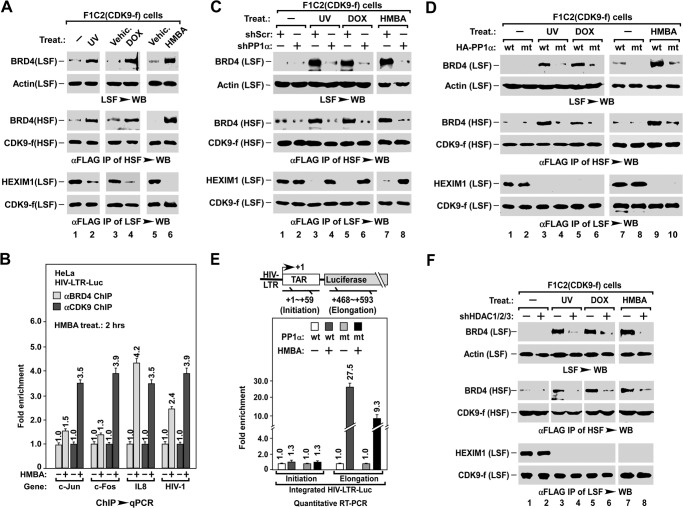FIGURE 7.
PP1α coordinates BRD4 release and P-TEFb liberation for regulating transcription elongation. A, effect of stress on BRD4 release, P-TEFb liberation, and BRD4·P-TEFb recruitment. F1C2(CDK9-f) cells were treated as indicated, followed by stepwise fractionation to yield the LSF and HSF. BRD4 released into LSF (top), BRD4 in association with P-TEFb in the anti-FLAG immunoprecipitates of HSF (middle), and HEXIM1 in association with P-TEFb in the immunoprecipitates from the rest of LSF (bottom) were examined by Western blotting (WB). B, ChIP-qPCR analysis of BRD4 and CDK9/P-TEFb levels at promoter regions of the indicated genes after HMBA treatments of HIV-LTR-luciferase cells. The levels in non-treated cells were set as 1. C and D, effect of silencing PP1α (B) or expressing H66N mt-PP1α (C) on stress-induced BRD4 release, P-TEFb liberation, and BRD4/P-TEFb recruitment. shScr, scrambled shRNA control. LSF and HSF were prepared as described in the legend to Fig. 3, B and C, and assayed as in A. E, inhibitory effect of H66N mt-PP1α on HMBA-induced transcription elongation of the HIV-LTR-luciferase gene. HIV-LTR-Luc cells with the indicated lentiviral infection and HMBA treatment were subjected to qRT-PCR analysis of the levels of initiation and elongation transcripts as illustrated in top panel. Data were averaged and presented as fold-enhancement compared with untreated sample. F, knocking down HDAC1/2/3 blocks BRD4 release, but not P-TEFb liberation. LSF and HSF were prepared from F1C2(CDK9-f) cells with the indicated lentiviral co-infection and treatments, and assayed as in A.

